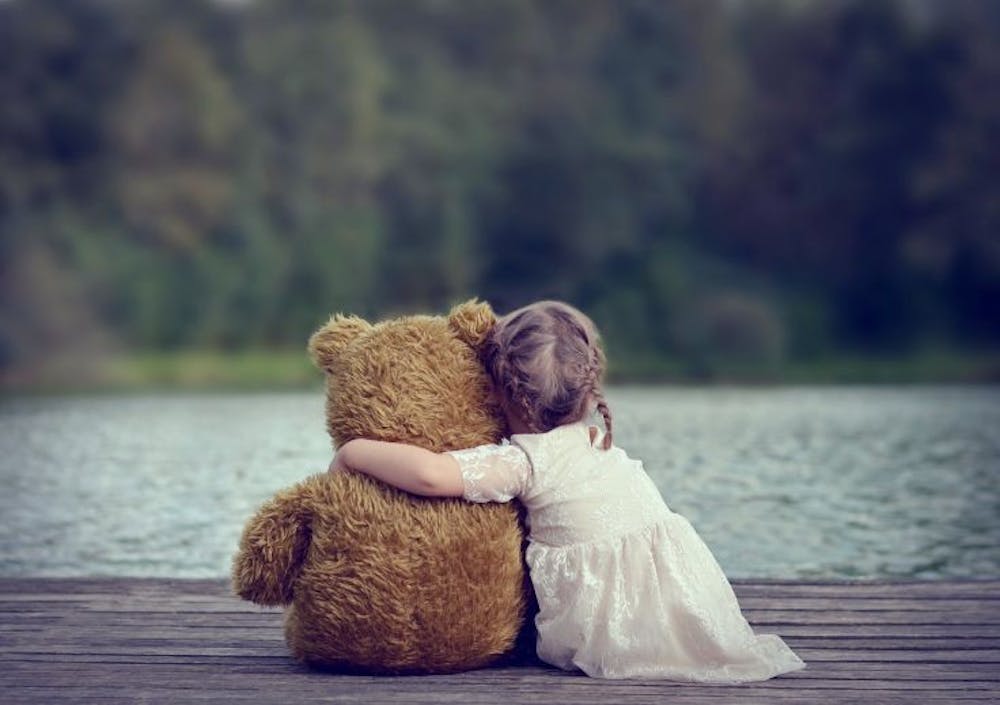I used to sleep with two comfort items: “Pooh” (a stuffed pooh bear with long–faded lettering on his red shirt) and the cleverly named “Pillow” (a small pink pillow with a pouch trimmed in lace). It didn’t feel right to bring them with me when I started college—I had NO idea what I’d be getting up to in my Quad double, but was fairly certain that I wouldn’t want the two most important objects of my childhood to be privy to any of it. They (and I) were still suffering from the trauma of a jarring afternoon 8 years earlier at summer camp, when I returned to my bunk to find that another girl had laid them on the floor in the middle of a circle of red duct tape with an “X” going through the center.
This incident, albeit completely psychopathic, was motivated by how overprotective I used to be of Pooh and Pillow. Now, although I still often bring them to bed when I’m home, the strict rules I used to impose on who could touch them, what surfaces they could lie on, etc. have been all but discarded. Slowly, like everyone else, I am outgrowing my childhood comfort items. They are a comfort, but not a necessity.
Psychologists call these types of comforts “transitional objects”. In childhood, transitional objects protect us against the threat of separation anxiety that a small kid might feel when their parents leave for work or drop them off at school. The way that a child interacts with transitional objects can even be indicative of how they will approach relationships with other people later in their lifetime. They provide us with some of our first experiences of consistent emotional connection, which is why we consider it “normal” to abandon them as we get older in favor of closer connections with other humans.
The gradual shedding of comfort items may be standard, but it is by no means universal. My mother, a physician, has always shared stories at the dinner table of interesting encounters with patients. The most memorable of these has been the story of a woman who, when asked by my mother how she was doing, responded, “I’m having a hard time…I’m not sleeping because Ernie’s at the doll hospital.”
Confused, my mom pressed this woman further, eventually getting her to reveal that she’d been sleeping with the same stuffed Ernie doll (of Sesame Street fame) since childhood. Her husband also had a stuffed toy from childhood, and only a week without hers while sending it out for repairs had pushed this woman nearly over the edge.
So why does this woman’s attachment to Ernie mean so much to her, even into adulthood? As it turns out, she isn’t as different as you might think from those of us who “moved on” from our first teddy bears or “blankies” (people who had “blankies”: did you all think you were original when you came up with that name? Seriously curious). Developmental psychologist Mark Brenner claims that we never fully abandon transitional objects or their presence in our lives. Rather, as we get older, we identify new objects that take on a similar sentimental value. You might not “cuddle” per se with a wedding band or the sign you drunkenly ripped off of your freshman dorm’s door during Hey Day, but the act of tying ourselves to objects in an emotional sense keeps us locked into the world in a way another person might not be able to.
The idea of “essentialism” suggests that to many of us, objects might be more than just their physical properties. Consider the items that have emotional significance to you. If someone offered you a trade for exact replicas of those items, even without wear or tear that the originals may have, would you take it? Bruce Hood of the University of Bristol has conducted various studies on this dilemma since 2007, all of which almost guarantee that your response would be a firm no.
So, let’s all agree not to give adults with stuffed animals such a hard time. Barring extreme cases where other areas of your life are affected (like the woman who suffered from crippling insomnia in Ernie’s absence), caring about your stuffed animals is psychologically normal and healthy, no matter your age. Your teddy bear and your Riepe hall sign will never leave you, and we could all use a good cuddle every once in a while.

